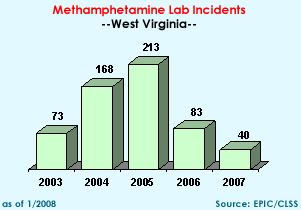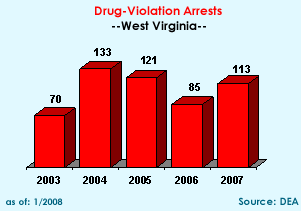DEA
Offices & Telephone Nos.
Charleston—304-347-5209
Clarksburg—304-623-3700
Wheeling—304-234-7772 |
State Facts
Population: 1,816,856
State Prison Population: 5,067
Probation Population: 6,977
Violent Crime Rate
National Ranking: 36 |
2007
Federal Drug Seizures
Cocaine: 5.7 kgs.
Heroin: 0.0 kgs.
Methamphetamine: 0.1 kgs.
Marijuana: 10.8 kgs.
Hashish: 0.0 kgs.
MDMA: 0.0 kgs/19 du
Meth
Lab Incidents: 40
(DEA, state, and local) |
Drug Situation: Largely rural, West Virginia's most pronounced drug problems involve the abuse and clandestine manufacture of methamphetamine, marijuana consumption and cultivation, and pharmaceutical drug diversion and abuse. Cocaine, crack, and MDMA are available in most areas of the state. Drug distributors in West Virginia are uniquely placed to take advantage of sources of supply from both nearby eastern cities like Baltimore, Pittsburgh, and Washington, DC, as well as large mid-western cities such as Columbus, Ohio and Detroit, Michigan.
 Cocaine: Cocaine hydrochloride and crack cocaine are widely available in most West Virginia cities. Crack cocaine abuse generally remains confined to low and low-middle income individuals, but crosses all ethnic lines. Rural communities have been drastically affected by crack distribution and accompanying violence. Cocaine availability is limited to large-retail or small-wholesale quantities. Source areas for cocaine are more varied than for other drugs consumed in the state and are largely based on the trafficker's location within West Virginia. Cocaine: Cocaine hydrochloride and crack cocaine are widely available in most West Virginia cities. Crack cocaine abuse generally remains confined to low and low-middle income individuals, but crosses all ethnic lines. Rural communities have been drastically affected by crack distribution and accompanying violence. Cocaine availability is limited to large-retail or small-wholesale quantities. Source areas for cocaine are more varied than for other drugs consumed in the state and are largely based on the trafficker's location within West Virginia.
 Heroin: Both the demand for and the availability of heroin are very limited throughout West Virginia. Small enclaves of long-term heroin addicts exist, who rely on one another to procure supplies of heroin from secondary source cities such as Philadelphia and Baltimore. The heroin sold in West Virginia typically retains the street/brand name and packaging of the Philadelphia or Baltimore-area supplier. Heroin: Both the demand for and the availability of heroin are very limited throughout West Virginia. Small enclaves of long-term heroin addicts exist, who rely on one another to procure supplies of heroin from secondary source cities such as Philadelphia and Baltimore. The heroin sold in West Virginia typically retains the street/brand name and packaging of the Philadelphia or Baltimore-area supplier.
  Methamphetamine: Clandestine methamphetamine laboratory activity in West Virginia, which has been very high, decreased because of state and Federal laws regulating the sale of precursors. Previously, methamphetamine manufacture appeared to be centered in the Panhandle region of the state, but has expanded to include other areas of northern West Virginia as well as some clandestine laboratory sites in the southeastern portion of the state bordering Kentucky and Virginia. In addition, methamphetamine distributors in West Virginia often share Mexican sources of supply with distributors in Virginia's Shenandoah Valley region. Methamphetamine: Clandestine methamphetamine laboratory activity in West Virginia, which has been very high, decreased because of state and Federal laws regulating the sale of precursors. Previously, methamphetamine manufacture appeared to be centered in the Panhandle region of the state, but has expanded to include other areas of northern West Virginia as well as some clandestine laboratory sites in the southeastern portion of the state bordering Kentucky and Virginia. In addition, methamphetamine distributors in West Virginia often share Mexican sources of supply with distributors in Virginia's Shenandoah Valley region.
 Club Drugs: There is increased demand for MDMA throughout West Virginia, but abuse remains concentrated near Morgantown, the location of West Virginia University. Demand for MDMA in college towns is sufficient to ensure that thousands of the pills reach West Virginia every month. Because of West Virginia's remote terrain, the area is purported to host numerous private "rave" parties but attendance at large-scale, publicized raves has been disappointing to promoters. Club Drugs: There is increased demand for MDMA throughout West Virginia, but abuse remains concentrated near Morgantown, the location of West Virginia University. Demand for MDMA in college towns is sufficient to ensure that thousands of the pills reach West Virginia every month. Because of West Virginia's remote terrain, the area is purported to host numerous private "rave" parties but attendance at large-scale, publicized raves has been disappointing to promoters.
 Marijuana: Both imported and domestic, locally cultivated marijuana pose a serious drug threat in West Virginia. Although the state ranks 37th in population in the U.S., West Virginia consistently ranks in the top ten states for marijuana eradication. West Virginia commonly serves as a source area for domestic marijuana. The Appalachia HIDTA was established initially to combat marijuana cultivation in the tri-state area - Ohio, Kentucky, and West Virginia - although that mission has expanded. However, Mexican commercial grade marijuana is still more prevalent than domestically cultivated marijuana in West Virginia. Marijuana: Both imported and domestic, locally cultivated marijuana pose a serious drug threat in West Virginia. Although the state ranks 37th in population in the U.S., West Virginia consistently ranks in the top ten states for marijuana eradication. West Virginia commonly serves as a source area for domestic marijuana. The Appalachia HIDTA was established initially to combat marijuana cultivation in the tri-state area - Ohio, Kentucky, and West Virginia - although that mission has expanded. However, Mexican commercial grade marijuana is still more prevalent than domestically cultivated marijuana in West Virginia.
 Pharmaceutical Diversion: Current investigations indicate that diversion of hydrocodone products and diazepam continues to be a problem in West Virginia. Primary methods of diversion being reported are illegal sale and distribution by health care professionals and workers, “doctor shopping” (going to a number of doctors to obtain prescriptions for a controlled pharmaceutical), employee theft, forged prescriptions, and the Internet. Alprazolam, Vicodin, and methadone were also identified as being among the most commonly abused and diverted pharmaceuticals in West Virginia. West Virginia leads the nation in methadone-related deaths per capita, and has the fastest-growing rate of methadone overdoses. Pharmaceutical Diversion: Current investigations indicate that diversion of hydrocodone products and diazepam continues to be a problem in West Virginia. Primary methods of diversion being reported are illegal sale and distribution by health care professionals and workers, “doctor shopping” (going to a number of doctors to obtain prescriptions for a controlled pharmaceutical), employee theft, forged prescriptions, and the Internet. Alprazolam, Vicodin, and methadone were also identified as being among the most commonly abused and diverted pharmaceuticals in West Virginia. West Virginia leads the nation in methadone-related deaths per capita, and has the fastest-growing rate of methadone overdoses.
 DEA Mobile Enforcement Teams: This
cooperative program with state and local law enforcement counterparts
was conceived in 1995 in response to the overwhelming problem of drug-related
violent crime in towns and cities across the nation. Since the inception
of the MET Program, 473 deployments have been completed nationwide, resulting
in 19,643 arrests. Since the inception of the program, there has been
one MET deployment in the State of West Virginia, in Charles Town. DEA Mobile Enforcement Teams: This
cooperative program with state and local law enforcement counterparts
was conceived in 1995 in response to the overwhelming problem of drug-related
violent crime in towns and cities across the nation. Since the inception
of the MET Program, 473 deployments have been completed nationwide, resulting
in 19,643 arrests. Since the inception of the program, there has been
one MET deployment in the State of West Virginia, in Charles Town.
DEA Regional Enforcement Teams: This
program was esigned to augment existing DEA division resources by targeting
drug organizations operating in the United States where there is a lack
of sufficient local drug law enforcement. This Program was conceived
in 1999 in response to the threat posed by drug trafficking organizations
that have established networks of cells to conduct drug trafficking operations
in smaller, non-traditional trafficking locations in the United States.
As of January 31, 2005, there have been 27 deployments nationwide, and
one deployment in the U.S. Virgin Islands, resulting in 671 arrests.
There have been no RET deployments in the State of West Virginia.
Other Enforcement Initiatives: The Appalachia HIDTA provides support to enforcement initiatives in the southern region of the state.
Special Topics: The
Washington/Baltimore HIDTA (High Intensity Drug Trafficking Area) supports
and assists in the funding of a multi-agency enforcement task force and
an Intelligence group in Washington, DC. In addition, the Washington,
DC Metropolitan Police Department has its own Major Narcotics Branch
and other drug and violent crime-related enforcement operations in place.
More information
about the Washington Division Office.
Sources
Factsheet last updated: 3/2008
Click here for last year's factsheet >>
|

